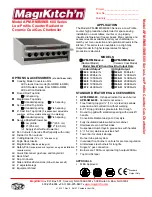
33
INS
TALLER
U
SER
M
AINTEN
AN
CE
TECHNI
CI
AN
TECHNI
CAL
D
AT
A
1.23 SYSTEM FILLING
1. Loosen the cap of the automatic vent valve on the circulating
pump.
2. Slightly open the filling cock (Par. 1.6) to ensure release of air
bubbles in the water via the boiler and central heating system
vents.
3. Open the radiator vent valves.
4. Close the filling cock when the boiler pressure gauge indicates
approx. 1.2 bar.
5. Close radiator vent valves when only water escapes from them.
During these operations activate the automatic venting
functions present in the boiler.
1.24 FILLING THE CONDENSATE DRAIN
TRAP
On first lighting of the boiler, flue gas
may come out the condensate drain; after
a few minutes’ operation check that this
no longer occurs. If this is the case, the
drain trap is correctly filled with conden-
sate up to a height that does not allow the
flue gas to pass.
1.25 GAS SYSTEM START-UP.
To start up the system, refer to the technical standards in force.
This divides the systems and, therefore, the commissioning ope-
rations, into three categories: new systems, modified systems, re-
activated systems.
In particular, for new gas systems:
- open windows and doors;
- avoid presence of sparks or naked flames;
- bleed all air from pipelines;
- ensure the internal system is properly sealed according to the
specifications set forth by technical regulations in force.
1.26 BOILER START-UP (IGNITION)
To commission the boiler (the operations listed below must only
be performed by qualified personnel and in the presence of staff
only):
1. check that the internal system is properly sealed according to
the specifications set forth by regulations in force;
2. Make sure that the type of gas used corresponds to boiler set-
tings (checking the the relevant “P01” parameter);
3. check that there is no air in the gas pipe;
4. check connection to a 230V-50Hz power mains, correct L-N
polarity and the earthing connection;
5. check that the intake/exhaust terminals are not obstructed
and that they are installed properly;
6. Check that the drain trap is full and that it prevents any passa-
ge of flue gas into the room;
7. check that there are no external factors that may cause the for-
mation of fuel pockets;
8. switch the boiler on and ensure correct ignition;
9. Check that the gas flow rate and the relative pressure values
comply with those indicated in the booklet;
10. ensure that the safety device intervenes in the event of gas sup-
ply failure and check the relative intervention time;
11. check the intervention of the main switch located upstream
from the boiler and in the boiler.
Even if just one single safety check provides a negative
result, do not commission the system.
















































